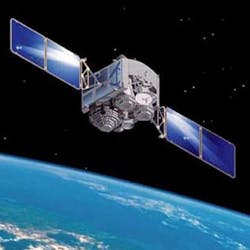THE AVIONICS INTELLIGENCE REPORT, 6 March 2012. Executive Editor Courtney E. Howard reveals that NASA officials will be auctioning off advanced software patents at the 15th ICAP Ocean Tomo IP Auction, to be heldn on March 29, 2012 in Rancho Palos Verdes, Calif. The auction features NASA Goddard Space Flight Center patent lots that include technologies related to: automated software generation, autonomic computing architectures, and autonomic management of environmental monitoring systems.
The space software technologies up for grabs were originally developed for the adaptive and autonomous control of satellite systems and other mission-specific needs. “These patent lots have diverse applications in software development, robotics, telecommunications, utilities, smart grids, wireless sensor networks, quantitative finance, and cyber security, among many others,” according to a technology manager at Goddard Space Flight Center. He adds that the patents hold value in any field where a need exists to design highly complex, automated, and intelligent systems.
Goddard Space Flight Center technologies up for sale include:
The three lots available include technologies related to automated software code generation, autonomic computing and autonomic safety systems. Potential applications include software development, robotics, telecommunications, utilities, smart grids, wireless sensor networks, quantitative finance, enterprise software, and cyber security among many others.
More broadly these patents hold value in any field where a need exists to design highly complex, automated, and intelligent systems.
Please see below for more details on the three lots of NASA Goddard’s software-related IP portfolios.
This lot includes technologies designed to greatly reduce the time and effort required to create software programs. These technologies can automatically create formal specifications and working code from informal input. Another important feature of this code generation technology is its ability to “run in reverse” and create a description of the code - in other words, a programmer can input source code, which will be converted into a formal mathematical model. This model is then translated into a description of the code.
These tools will enable software dependability in purpose specific, complex systems and can help in creating systems that are easier to use and maintain in the face of growing system complexity.
Patent | GSFC Case Number | Title | Description |
GSC-14389-1 | System And Method For Deriving A Process-Based Specification | This is a core technique for mechanically deriving both a formal specification and executable computer code from both English language and programming language representations of scenarios of hardware or software system behavior. The formal specifications provide a means to check the scenarios for potential errors that are difficult or nearly impossible to find with specifications that have no formal underlying mathematical foundation. From the formal specification, this technique automatically generates computer-executable code, which will ensure that no errors are introduced into the code from manual coding. Such an approach enables less time spent on coding and developing test cases, which reduces development time, and enables higher quality systems with less expense. This automatic code generation is efficient, reduces errors and supports a full development life cycle. | |
GSC-14941-1 | Systems, Methods & Apparatus For Implementation Of Formal Specifications Derived From Informal Requirements | This approach describes systems, methods and apparatus to transform informal system requirements into a provably equivalent formal model. Input can be natural language, graphical notations, programming languages or others. These inputs describe the software's actions in response to incoming data and the internal goals of the software. A scenario can describe one or more potential executions of a system, describing what happens in a particular situation and what range of behaviors is expected from or omitted by the system under various conditions. | |
GSC-14942-1 | Systems, Methods And Apparatus For Verification Of Knowledge-Based Systems | This patent describes the use of an “inference engine” for converting system rules into a process-based specification that can then be analyzed. | |
GSC-15043-1 | Systems, Methods And Apparatus For Procedure Development And Verification | This innovation enables a model to be analyzed for contradictions, conflicts, and use of resources before the resources are available, competition for resources etc. The result is greatly improved code. | |
GSC-15079-1 | Systems, methods and apparatus for generation and verification of policies in autonomic computing systems | In this invention, policies developed for autonomic computing systems can be verified, to ensure that the policies are both reasonable and complete. The code for implementing these policies can then be automatically generated. More specifically, the technology described herein provides automated analysis, validation, verification, and generation of complex procedures, often implemented as policies. The systems, methods and apparatus may include inferring an equivalent formal model from one or more policies. Such a model can be analyzed for contradictions, conflicts, use of resources before the resources are available, competition for resources, and so forth. From such a formal model, an implementation can be automatically generated in a variety of notations. An implementation may include traditional programming language code, machine language code, scripts, and/or procedures. | |
GSC-15080-1 | Systems, Methods, and Apparatus for Pattern Matching in Procedure Development and Verification | This approach describes where formal specifications are pattern-matched from scenarios, then analyzed, and any flaws in formal specifications are corrected. | |
GSC-15178-1 | Systems, Methods, and Apparatus For Modeling, Specifying and Deploying Policies In Autonomous and Autonomic Systems Using Agent-Oriented Software Engineering | This patent describes using graphical notation based on UML for specifying policies for autonomic systems. It encompasses an agent-oriented software-engineering (AOSE)-based approach for modeling autonomous and autonomic properties of a system. The approach produces fully (mathematically) tractable development of agent-oriented specification(s) modeled with a methodology fragment for analyzing complex multiagent systems (MaCMAS) and policies for autonomic systems from requirements through to code generation |
This patent lot includes a number of technologies that mimic autonomic biological functions. GSFC has adapted the concept of apoptosis (programmed cell death) as a way to help manage large, complicated computer systems. This functionality can be an important tool for system management, since it helps ensure that the only active parts of an environment are the components that are actually needed -- the ones that aren’t of value are automatically taken offline.
To manage this apoptosis process, GSFC takes further inspiration from biological systems, using two autonomic components similar to biological heartbeats and pulses. The heartbeats and pulses allow the autonomic system to manage, assess, and react to the performance and health status of agents in the system.
Patent | GSFC Case Number | Title | Description |
GSC-14968-1 | Swarm Autonomic Agents with Self-Destruct Capability | Here, an autonomic entity manages a system by generating one or more stay alive signals based on the functioning status and operating state of the system. The evolvable neural interface receives and generates heartbeat monitor signals and pulse monitor signals that are used to generate a stay alive signal that is used to mange the operations of a synthetic neural system. In certain instances select agent self destruction is possible for self protection of the entire system. | |
GSC-14968-2 | Swarm Autonomic Agents with Self-destruct Capability | This is an update to patent US 7,627,538, and includes claims about use in autonomous nanotechnology swarms. Details relayed include urgency signals, reflex signals, environmental conditions, or event conditions. Depending upon the requirements, the autonomic system will be able to operate and control certain agents/nodes, assess their condition (incorrect operation, emergent behavior, failure to perform self healing, or likelihood of jeopardizing primary objectives) and have the ability to continue as planned or to initiate a self destruction sequence. | |
GSC-15038-1 | System And Method Of Self- Properties For An Autonomous And Autonomic Computer Environment | This patent describes the ability for managing, transmitting and receiving self health/urgency data and environment health/urgency data from an autonomic element. | |
GSC-15176-1 | Systems, Methods, and Apparatus for Quiesence of Autonomic Systems with Self Action | This patent describes the process for disabling an autonomic/autonomous unit, agent or element. |
This patent lot exploits GSFC’s biological pulse technology (based on a double-heartbeat “lub dub” signal described in Lot 2) to autonomically manage and detect faults or failures in alarm networks such as alarms, sprinkler systems, satellites, and really any "sensor network" or monitoring system where a number of simple sensors may be used together in a way that collects information regarding the status of various devices.
Patent | GSFC Case Number | Title | Description |
GSC-15179-1 | Systems, methods and apparatus for quiesence of autonomic safety devices with self action | This autonomic safety device medium has a set of instructions to direct a processor for receiving a quiesce instruction. A function of a quiesce component of an autonomic environmental safety device e.g. smoke detector, is invoked. An environment health/urgency data is transmitted before transmitting a self health/urgency data. The environment health/urgency data and the self health/urgency data are transmitted together. The environment and the self health/urgency data are encapsulated in a packet. The environment health/urgency data is received from an environment control loop component of the safety device. |
For more information about the Goddard Space Flight Center technologies being auctioned off, visit: http://ipp.gsfc.nasa.gov/icap_auction.
The auction follows an annual industry event: Navigating the Catalina Channel: The ICAP Patent Brokerage Summit on IP Strategy and 15th ICAP Ocean Tomo IP Auction, held March 28-29, 2012 at Terranea Resort, Rancho Palos Verdes, Calif. Information about registering for the auction and the bidding process is offered at the ICAP Auction Web site at: http://icappatentbrokerage.com/auction/spring2012.

Courtney Howard | Executive Editor
Courtney, as executive editor, enjoys writing about all things electronics and avionics in PennWell’s burgeoning Aerospace and Defense Group, which encompasses Military & Aerospace Electronics, Avionics Intelligence, the Avionics Europe conference, and much more. She’s also a self-proclaimed social-media maven, mil-aero nerd, and avid avionics geek. Connect with Courtney at [email protected], @coho on Twitter, and on LinkedIn.

